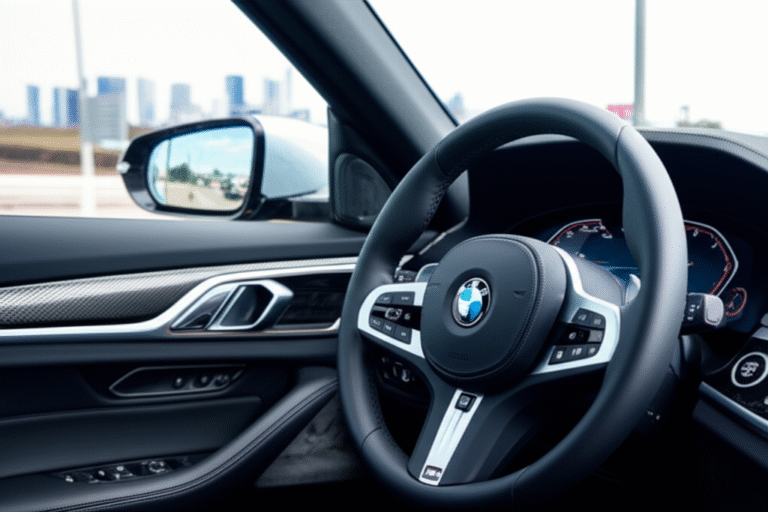BMW Colour Code Dustbin: 6 Must-Knows

BMW Colour Code Dustbin: 6 Must-Know Details Every Owner Needs
Understanding your BMW’s colour code is crucial for maintaining its pristine finish. This guide, the “BMW Colour Code Dustbin: 6 Must-Know Details,” simplifies locating and using this vital information for paint touch-ups, repairs, or simply knowing your car’s unique hue.
Key Takeaways
- Locate your BMW’s paint code accurately.
- Understand the colour code format.
- Find the colour code in common BMW locations.
- Use the code for perfect paint matching.
- Differentiate between paint code and shade variations.
- Know when to consult a professional.
As a BMW owner, you appreciate the exceptional craftsmanship and distinctive style of your vehicle. Maintaining that iconic look is important, and a key part of that is understanding your car’s specific paint colour. Have you ever wondered how to perfectly match a scratch or how to order the exact right shade for a touch-up? The answer often lies in a small, unassuming piece of information: your BMW’s paint colour code. This code, sometimes referred to informally as the “colour dustbin” due to where the paint chip might be kept or where information is stored, is your golden ticket to a flawless finish. It’s more than just a number and a few letters; it’s the precise recipe for your BMW’s unique exterior hue. Let’s dive into the six essential things you need to know about this critical piece of automotive information.
In This Article
- 1 1. What is Your BMW Paint Colour Code?
- 2 2. Where to Find Your BMW Colour Code: The “Dustbin” Locations
- 3 3. Understanding the BMW Colour Code Format
- 4 4. Using Your BMW Colour Code for Perfect Paint Matching
- 5 5. Beware of Shade Variations and Paint Degradation
- 6 6. When to Consult a Professional for BMW Paint Repair
- 7 Frequently Asked Questions (FAQ)
- 7.1 What if I can’t find the sticker with my BMW colour code?
- 7.2 Can I use a generic touch-up paint if I don’t have the code?
- 7.3 Does the BMW colour code include the clear coat?
- 7.4 How long does BMW touch-up paint last?
- 7.5 What’s the difference between a metallic and non-metallic BMW paint code?
- 7.6 Can I paint my entire BMW myself using the colour code?
- 8 Conclusion
1. What is Your BMW Paint Colour Code?
Your BMW paint colour code is a unique identifier assigned by the manufacturer to a specific paint finish. Think of it as your car’s fingerprint for its colour. This alphanumeric code ensures that when you need to repair or touch up paint, you get an exact match. Without it, you might end up with a paint job that looks slightly off, especially under different lighting conditions. This is particularly important for luxury vehicles like BMW, where aesthetic perfection is paramount. The code specifies not only the base colour but also the specific pigment composition, metallic flake, or pearl effect that gives your BMW its signature look.
The importance of this code cannot be overstated, especially when dealing with custom finishes, metallic paints, or multi-stage paint systems that BMW is known for. Relying on a general colour name can lead to disappointment. For instance, “Black” can come in many shades and finishes, from solid gloss to metallic deep black. The colour code eliminates this ambiguity, ensuring consistency and quality in any paintwork.
2. Where to Find Your BMW Colour Code: The “Dustbin” Locations
The term “colour dustbin” is a colloquialism that often refers to the physical location where a paint sample or the code itself might be documented or stored by the manufacturer. Historically, car manufacturers might have kept a small paint chip or a sticker with the code inside the car or in the service documentation. For BMW, these locations are generally standardized, making it easier for owners to locate this vital information themselves. Knowing where to look can save you time and the expense of having a dealership or a paint shop try to guess your car’s colour.
Here are the most common places to find your BMW paint colour code:
- Service History Book/Manual: Sometimes, dealerships or previous owners might have recorded the paint code in the vehicle’s service book or owner’s manual. This is an excellent place to start if you have access to these documents.
- Under the Hood/Door Jamb Sticker: BMWs, like most vehicles, have a sticker located in one of several places that contains a wealth of information about your car, including the VIN, manufacturing date, and importantly, the paint colour code.
- Trunk Lid Sticker: In some BMW models, this sticker might also be found on the underside of the trunk lid.
- Original Bill of Sale or Lease Agreement: While less common, the exact paint colour code might be listed on your original purchase documentation.
Common Sticker Locations for BMW Colour Codes
The most reliable place to find your BMW’s paint colour code is on a sticker typically found in one of these locations:
- Driver’s Side Door Jamb: Open the driver’s door and look at the B-pillar (the post between the front and rear doors). There’s usually a sticker here showing vehicle data.
- Passenger’s Side Door Jamb: Similarly, check the sticker on the B-pillar on the passenger side.
- Under the Hood: Open the hood and look for a sticker on the firewall, suspension towers, or the underside of the hood itself.
When you locate the sticker, you’ll need to identify the paint code. It’s usually clearly labeled, often with terms like “Farbe” (German for colour), “Paint Code,” “Code,” or a specific code number next to a colour name or description. It’s typically a three-digit alphanumeric code.
3. Understanding the BMW Colour Code Format
BMW paint colour codes are generally quite straightforward but can appear in a few different formats depending on the year of manufacture and the specific paint type. The most common format is a three-digit alphanumeric code. For instance, you might see codes like 300, 475, A96, or A83.
Let’s break down what these codes typically represent:
- Three Digits: The core of the BMW paint code is usually three digits. For example, ‘300’ is Alpine White, a very common BMW colour. ‘475’ is Black Sapphire Metallic.
- Prefixes (Optional): Sometimes, you might see a prefix, such as ‘A’ or ‘B’. These prefixes often indicate the pigment or base coat used in the paint formulation. For example, ‘A96’ might refer to a specific type of white.
- Additional Numbers: In some cases, especially with more complex or newer paint technologies (like metallic or pearl effects), there might be additional numbers or letters following the main code. However, for most common touch-up paint needs, the primary three-digit or four-character code is what you’ll focus on.
It’s crucial to note that the code itself is usually just the numerical or alphanumeric identifier. The descriptive name of the colour (e.g., “Alpine White,” “Black Sapphire Metallic”) is also important for human reference but the code is the definitive identifier for ordering paint. Always double-check the exact code on your vehicle sticker against any documentation or online resources.
BMW Paint Code vs. BMW Colour Name
It’s important to distinguish between the BMW paint code and the BMW colour name. While the name helps you identify the colour, the code is the precise technical specification for the paint manufacturer. For example:
| Paint Code | Colour Name | Notes |
|---|---|---|
| 300 | Alpine White | A solid, non-metallic, very popular white. |
| 475 | Black Sapphire Metallic | A deep, rich black with metallic flecks visible in sunlight. |
| A96 | Mineral White Metallic | A bright, pearlescent white with a subtle sparkle. |
| A83 | Glacier Silver Metallic | A bright, clean silver with a noticeable metallic finish. |
| B39 | Mineral Grey Metallic | A sophisticated, deep grey with metallic undertones. |
As you can see, even slight variations in the code can represent significantly different colours and finishes. Always use the code for ordering paint.
4. Using Your BMW Colour Code for Perfect Paint Matching
Once you’ve found and verified your BMW’s paint colour code, the next step is using it to achieve a perfect paint match. This is essential for any paint repair, whether it’s a small scratch, a chip from road debris, or a larger panel repair. Using the correct code ensures that the new paint seamlessly blends with your car’s existing finish, maintaining the factory look you desire.
Here’s how to effectively use your code:
- Touch-Up Pens/Bottles: Many automotive paint suppliers offer touch-up paint kits that can be ordered by your BMW colour code. These kits typically include a small amount of paint and an applicator. They are ideal for minor chips and scratches.
- Spray Cans: For larger areas or more extensive repairs, you can order aerosol spray cans formulated to your specific colour code. These require more skill to apply but can cover larger areas effectively.
- Professional Paint Shops: When visiting a professional auto body shop or paint specialist, provide them with your paint code. This allows them to accurately mix the paint, ensuring a precise match. They will likely also have a database to cross-reference your code and may even factor in the age of your paint to account for fading.
When ordering paint, always confirm the colour code and the descriptive name. If you’re purchasing from an online supplier or a parts counter, they will usually ask for both. This double-check helps prevent errors. For example, if you have a 2020 BMW X5 and provide code 475, they will supply Black Sapphire Metallic. If you mistakenly provide a code for a different black, the result will be noticeable.
Pro Tip: Before applying any touch-up paint, clean the damaged area thoroughly and lightly sand it if necessary. For best results, apply thin coats and allow adequate drying time between each application.
5. Beware of Shade Variations and Paint Degradation
Even with the correct colour code, achieving a perfect match can sometimes be challenging due to factors like paint fading, environmental exposure, and different manufacturing batches. BMW, like all manufacturers, uses sophisticated paint technologies, including metallic and pearl finishes, which can be tricky to replicate perfectly, especially after years of exposure to the elements.
Here’s why shade variations can occur:
- UV Exposure: Sunlight’s ultraviolet (UV) rays can degrade automotive paint over time, causing it to lighten or change hue. A car that is ten years old will likely have a slightly different shade than when it rolled off the assembly line.
- Environmental Factors: Pollution, road salts (especially in areas like the USA that use salt in winter), and harsh weather conditions can also affect the paint’s integrity and appearance.
- Paint Batch Variations: While manufacturers strive for consistency, slight variations can occur between different paint batches produced at different times.
- Application Differences: The way paint is applied can also affect how it looks. For instance, a spray can applied by an amateur might not achieve the same finish as a factory robot.
Because of these variables, professional auto body shops often have a system for “blending” the new paint into the surrounding original paint. This involves applying the new paint to the damaged area and then feathering it out slightly onto the adjacent panels so that any minor colour difference is imperceptible. For DIY touch-ups, using a product from a reputable supplier that is specifically formulated for your BMW’s colour code is the best approach to minimize these issues.
You can learn more about automotive paint technology and repair from resources like the Automotive Refinish Training Center, which offers insights into professional paint application and colour matching techniques.
6. When to Consult a Professional for BMW Paint Repair
While DIY touch-up paint kits are convenient and cost-effective for minor imperfections, there are times when seeking professional help is the most sensible option. For larger areas of damage, complex paint finishes, or when you simply want a flawless, factory-new appearance, a professional’s expertise is invaluable.
Consider consulting a professional if:
- Damage is Extensive: Deep scratches, large chips, significant scuffs, or damage that extends beyond the clear coat require professional assessment and repair.
- Complex Paint Systems: If your BMW has a multi-stage paint, a metallic finish with a fine flake, or a pearlescent effect, achieving a perfect DIY match can be extremely difficult. Professionals have specialized equipment and experience to handle these.
- You Lack Experience: Applying spray paint evenly, avoiding drips, and achieving a smooth finish takes practice. If you’re not confident in your ability to do so, it’s better to let a pro handle it to avoid creating more noticeable imperfections.
- The Goal is Perfection: True automotive enthusiasts often desire a “like-new” finish. Professional detailers and body shops employ techniques like wet sanding, polishing, and clear coat application that are hard to replicate at home.
- Colour Matching Challenges: If you’ve tried a DIY touch-up and the colour is noticeably off, a professional can help diagnose the issue and correct it. They have access to a wider range of colour-correction tools and pigments.
BMW’s dedication to engineering excellence extends to their paint finishes. While simple touch-ups are manageable for some owners, preserving the integrity and beauty of a luxury vehicle often benefits from the skilled hands and advanced tools of a professional auto body shop or a high-end car detailing service. They can ensure that your BMW not only looks its best but also maintains its resale value.
For those in the USA looking for reputable professionals, organizations like the Society of Collision Repair Specialists (SCRS) provide resources and directories of certified repair facilities. These professionals are trained to work with a wide array of vehicle makes and models, including premium brands like BMW.
Frequently Asked Questions (FAQ)
What if I can’t find the sticker with my BMW colour code?
If the sticker is missing or illegible, your best bet is to contact a BMW dealership. With your car’s Vehicle Identification Number (VIN), they can look up the original factory specifications, including the exact paint colour code, in their system.
Can I use a generic touch-up paint if I don’t have the code?
It’s strongly advised against using generic touch-up paint. The chances of getting an accurate match are very slim, and you risk making the imperfection more noticeable. Always try to find your BMW’s specific colour code.
Does the BMW colour code include the clear coat?
The colour code itself typically refers to the base coat of paint. However, when ordering touch-up paint or professional paint, the system will usually account for the necessary clear coat and any primer layers required for a complete repair.
How long does BMW touch-up paint last?
When applied correctly and stored properly (in a cool, dry place), BMW touch-up paint can last for several years. The longevity also depends on the quality of the paint supplier and the environmental conditions it’s exposed to.
What’s the difference between a metallic and non-metallic BMW paint code?
A non-metallic paint (like solid Alpine White) is a single-stage colour. Metallic paints contain tiny flakes of aluminum that reflect light, giving them sparkle and depth. Pearl paints have a similar effect but use pearlescent pigments. While the underlying code identifies the base colour, the presence of metallic or pearl effects is part of the paint’s formulation and is captured by the code.
Can I paint my entire BMW myself using the colour code?
While technically possible with spray cans, painting an entire car at home is an extremely advanced project. It requires significant skill, specialized equipment (like a spray gun, compressor, and paint booth), and a deep understanding of paint application and finishing to achieve professional results. For a full repaint, professional services are highly recommended.
Conclusion
Understanding and locating your BMW’s colour code, often referred to as the “colour dustbin” information, is a fundamental step in maintaining your vehicle’s aesthetic appeal. Whether you’re dealing with a minor scratch, planning a larger repair, or simply want to ensure you have the correct information for future needs, knowing this code is essential. By identifying it through common locations like door jamb stickers, understanding its format, and using it diligently for paint matching, you can preserve the signature look of your BMW. Remember that while DIY solutions are available, complex finishes or extensive damage may warrant professional expertise to guarantee a seamless, factory-quality result. With this knowledge, you’re well-equipped to keep your BMW looking its absolute best on every drive.






